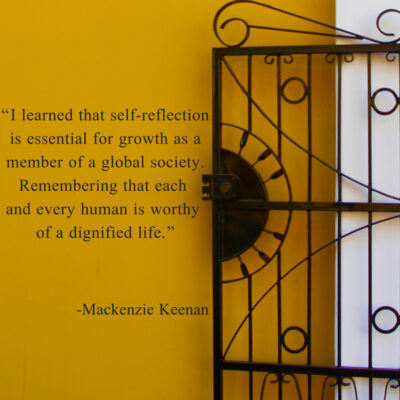Quinnipiac’s community engagement programs strive to form ethical global citizens
By Tatyana Youssef
As senior Mackenzie Keenan approaches the podium, administrators hand her a glass award. With a humble smile, Keenan accepts her recognition for “Global Citizen of the Year” at the undergraduate awards ceremony on April 20.

Keenan traveled to Nicaragua three times during her four years at Quinnipiac. As a second-time student leader, she learned something new after each Global Solidarity trip. Every year, working with the Alianza Americana Institute in the city of León opened her eyes to a new aspect of humanity and cemented her connections.
“I learned that self-reflection is essential for growth as a member of a global society,” she says. “Remembering that each and every human is worthy of a dignified life.”
The evolving engagement with host families in a community known as La Villa shaped Keenan’s values and beliefs, which she plans to carry into her future career in healthcare. More importantly, she thanks her experiences in Nicaragua for contributing to her personal growth and progressive beliefs.

“To me, global solidarity is understanding that no perceived difference, whether that be skin color, religion, sexual orientation, whatever nonsense you can come up with, will diminish the responsibility owed by the rest of society to that person to provide basic human respect,” she says.
However, students returning from trips in developing nations are not always like Mackenzie Keenan.
The ideal outcome of the trip is for students to expand their mind, gain equal perception of the people they met, and make connections to our society. At Quinnipiac University, dozens of students travel each year in so-called global solidarity programs.The university is still refining what those trips mean and designing curricula to guide students toward ethical engagement abroad.
Despite 11 months of pre-departure education, the outcomes are still not clearly articulated. Before the title of the trip became “Global Solidarity” it was known as “Alternative Spring Break.” The shift in title reflects the central focus, as global solidarity hints at service learning while alternative spring break is a travel option without a clear educational component.
Quinnipiac’s Department of Cultural and Global Engagement is working to improve abroad opportunities, instilling essential educational outcomes. Erin Sabato, the university’s Director of International Service and Learning, plays a major role in the program’s development.
Sabato has traveled to Nicaragua numerous times throughout the last 14 years, feeling a great connection to the resilient nation she calls home. When reflecting on the program’s format years ago, Sabato says,”There was a lot of emphasis on exposure to poverty, and while I think that is important, there needs to be context. There’s a fine line between exploitation and educating our students, and that needed to be examined and put into better context.”

Junior psychology major Mikaela Rooney experienced Nicaragua for the first time as a global solidarity delegate this past March.
“Erin Sabato has truly molded the global solidarity program into one that is ethical and informative,” she says.
Global solidarity promotes a horizontal mentality when collaborating with other countries, featuring an equal exchange of culture and compassion while working toward the same goal. Sabato visualizes global solidarity as people standing shoulder to shoulder.
“Equal exchange is the idea that we are not forcing our ‘help’ onto people who we perceive as needy,” Rooney said. “We go into communities in places like Nicaragua not to educate, but to learn from each other.”
Ideally, the concept moves us toward actions of collaboration and engagement, working side by side with global members despite coming from different walks of life. Coming from a higher learning institution in the United States, Sabato emphasizes the importance of checking privilege and positionality when entering developing nations.
“It’s more about this horizontal partnership as opposed to this vertical kind of global north, global south relationship,” she says. “The program needs to be community driven–the community members’ voices need to be at the forefront.”
Before entering a new country, students are trained on the culture and historical context as part of pre-departure education. Chief Diversity Officer Don Sawyer has an interesting take on global solidarity and how it should be facilitated.

“The global solidarity piece is building the relationship – that’s what it is in title. But what it is in action still needs to be hammered out,” he says.
There is an element of inquiry that goes with pre-departure education along with readings, videos and discussions. Sawyer poses questions to make students think from a sociological perspective.
“What does it mean to travel, what does it mean to be an American citizen in another nation, what does it mean to be a white American in a nation of people of color, what does it mean to be a person of color going to that nation with a history of racial issues?” he asks.

Sawyer believes that challenging student thought is vital to the learning experience. Global solidarity is effective when students are able to make connections at home.
“You didn’t need to travel six hours to understand poverty, ya know?” he states.“There’s poverty around us everywhere if you were to open your eyes and take a look, so a part of these trips and the struggle in doing international work is getting students to see how the local and the national is also connected to the global.”
Sabato agrees with the significance of making connections at home after traveling. Students are impressed by the sense of community in these nations, however they seem to forget the community around them at home, according to Sabato.
“I think students need to make better connections about what’s happening here, we’re all concerned about what’s happening in Nicaragua understandably so, but why can we not make that connection about oppression here?” she asks.
Quinnipiac University’s relationship with Nicaragua’s Alianza Americana Institute is reaching its second decade in partnership. The Alianza translators teach English to students in the country and become like family to Quinnipiac students. The bond within this delegation is strong, as global solidarity is practiced when students rely on translators for understanding every interaction. Anyoleth Rizo Gutierrez, 19, has worked with Alianza for two years, after excelling in English herself when she finally broke out of her shell through the confidence she found through this second language.

Rizo Gutierrez sees growth within Quinnipiac students throughout each trip, especially the bonds they form with their host families in La Villa.
“You see the difference from the first day to the last day,” she says. “They are always crying when they leave because they have a family here.”
However, the closeness does not always happen so smoothly. She recalls a disheartening experience regarding a Quinnipiac student who did not understand the meaning of global solidarity.
“Last year in my first delegation, she was like, ‘Oh, this kid is dirty, I don’t want to touch him.’” Rizo Gutierrez says the child no longer had a family, taken in by the school the Quinnipiac students were working with that week.
“And then we had a beach trip and I saw her with the kid, and I was like, ya know, maybe something changed in her,” she says. “ I think maybe she realized the story he had behind him. Sometimes Quinnipiac students, they live in this bubble, like the United States.”
College is a privilege in Central America, while students in the United States are societally expected to attend an institution of higher learning after receiving their high school diploma. Growing up in Costa Rica with a single mother Rizo Gutierrez learned to be strong and to rely on steady, hard work. Rizo Gutierrez does not take her education for granted.
The delegation between Quinnipiac and Alianza shows an exchange of humanity and understanding. Despite differences in living conditions and experiences, students are able to bond with the translators when humanity and empathy are put at the forefront of the engagement.
Sabato talks about the importance of empathy through the act of continuous support.
“Solidarity, to me, means that I may not understand your struggle, I may never be in your shoes, yet I will continue to stand beside you, continue to support you and your struggle in reaching your objective,” she says.
Sawyer recalls bonding with Haitian community members in the Dominican Republic through a cultural swap of dancing.
“They were teaching us Haitian dances and then we were teaching them American dances like the electric slide and the wobble, so there was this exchange,” he says.
Granted, people’s lives aren’t going to be changed from learning the wobble, Sawyer adds, “but seeing a relationship being built that wasn’t like what they tend to see when people just come, drop off rice, and leave –- there was actual engagement.”
Sawyer and his students witnessed a group from Canada drop off rice at doors in the community without any true engagement.
“They came in, went to the doors, handed out rice and beans, lifting up these kids from behind, hugging them, kissing them, taking pictures and then they left,” he says.
The use of photography during these trips can be particularly problematic, both Sawyer and Sabato say. Today’s generation puts a large emphasis on documenting experiences through the use of social media. As more and more students travel abroad, social media feeds tend to be filled with unrealistic, staged photographs. The Canadian group inserted themselves into the community by only ‘giving’ and over-affectionately interacting with the children when the cameras came out, according to Sawyer.

This creates harm with visual exploitation, as photographs taken during these trips often show power dynamics with white volunteers from the global north smiling, standing above the loving, brown children positioned below or around them. Parental consent is usually unavailable in these circumstances. However, the students pose with the children’s faces regardless.
“We were not picking up kids and putting them on Instagram and Twitter, that’s not what it was about,” Sawyer says. “In those pre departure meetings we talk about responsible photography so most of the trip, hopefully we got photos of the trip, but people had their phones away- they were mostly engaging.”
In November 2017, the internet reacted to a viral photo of a white European tourist holding a young child in Kenya. As the child’s head leans on top of her shoulder, Jossa Johansson captioned her image on Instagram with ignorant words, including the lack of opportunities in the child’s future.
“One of the happiest moment in your life was probably when you met me and my friends,” Johansson wrote.”I am sorry to tell you that there is a very slim chance we will ever meet again.”
The Instagram post went viral, as viewers expressed harsh, justified opinions on Facebook and Twitter.
Wambugu Muthee on Twitter
@xtiandela @jossajohansson @Jossie_99 Your post is a disgrace. The least you can do is apologize for portraying such false. I can’t fathom what kind of a horrid person could go ahead and imagine a child selling herself. In the name of help, there’s something awfully wrong with you.
Criticism included the need for ethical boundaries and need for education when traveling to other nations.
Although an incident of this magnitude has never occurred at Quinnipiac, Sawyer still sees the need for continuing education.
“This shows with all the work we’re doing, we need to do more,” he says.
The importance of ethical boundaries regarding photographs is discussed in the pre-departure meetings through articles and videos the students watch and analyze. Sabato states that she expects students to be engaged during each meeting.
Components to the pre-departure training include knowledge on the history of the partnership and who the stakeholders are abroad.
“I expect them to want to learn about the countries they are traveling to, the community members they will be working with, the ethics behind how to engage in these programs as a university, and what our role is as a university,” she says.
Sabato hopes that going forward these pre-departure experience will help avoid ethical lapses.

Through inquiry and dialogue, Sabato ensures that each student is actively reflecting during the experience. She challenges students to be critical of themselves and their preconceived ideas, setting time in the itinerary for daily discussions on privilege, equality and cultural exchange. Sabato plans to continue these efforts, encouraging students to stay active through the entire process while maintaining a sense of cultural humility.
“It’s important to recognize what we don’t know,” she says. “It’s important to recognize the assets and the value that our partners bring to the table in this equation. And then I expect students to come back, take what they’ve learned and think about how to apply it in their future.”








